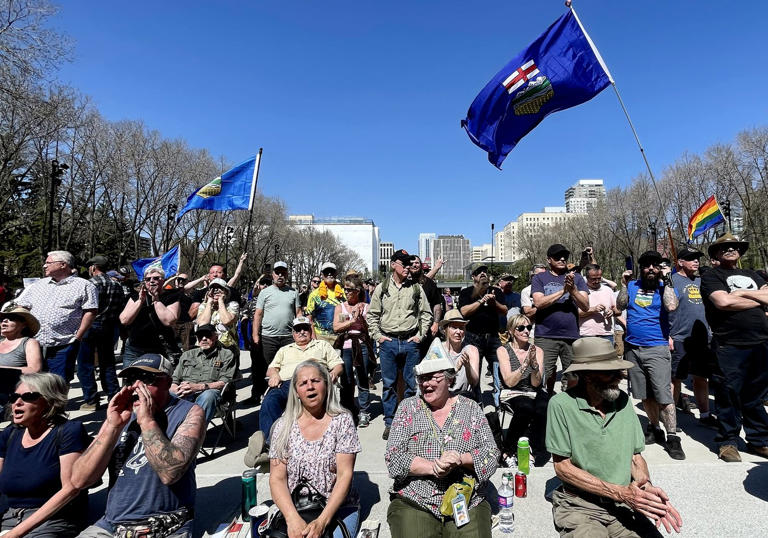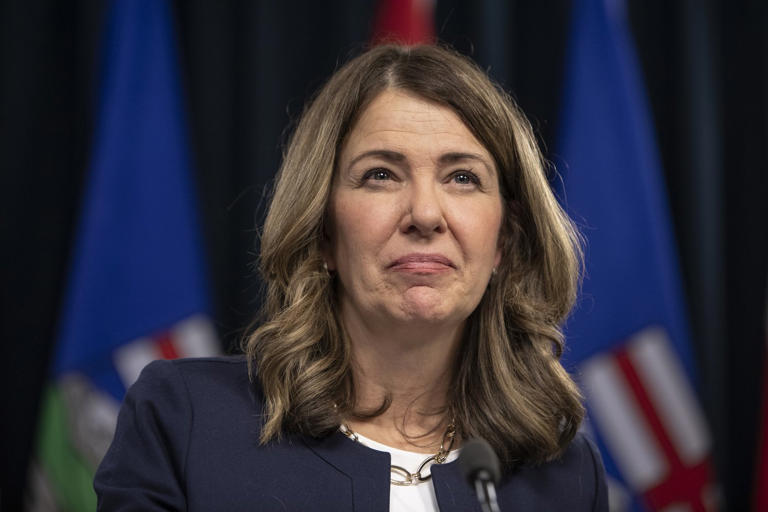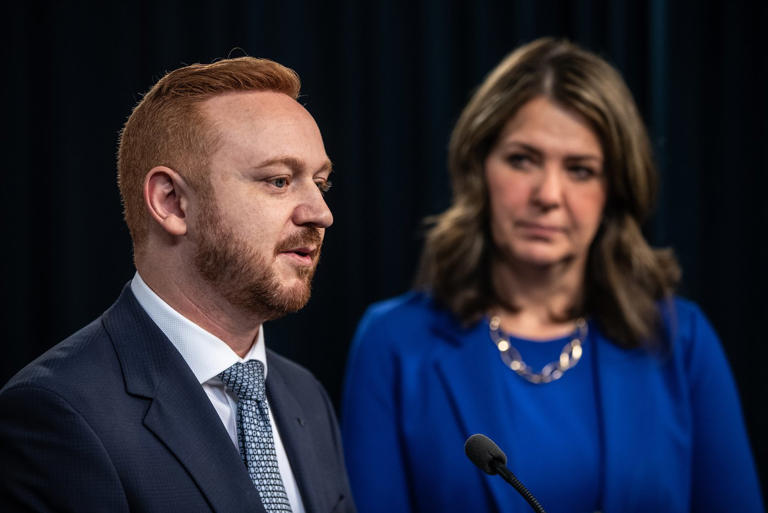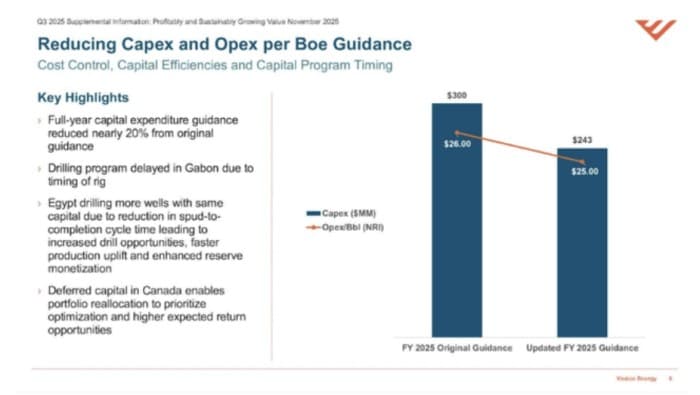ByThe Canadian Press
Published: December 22, 2025

OTTAWA — U.S. President Donald Trump’s tariff campaign appeared to move at a breakneck pace towards Canada’s economy this year.
But beyond threats of double-digit tariff rates and sharp pain in manufacturing-heavy industries, a key exemption has allowed the majority Canadian goods to continue to cross the southern border duty-free.
Experts who spoke to The Canadian Press warned this saving grace for the economy is at risk in 2026 as North American trade officials prepare for a review of the Canada-U.S.-Mexico agreement, or CUSMA.
“It would be a worst-case scenario of the (CUSMA) deal basically being eliminated or not renewed,” said Tony Stillo, director of Canada economics at Oxford Economics.
“And that would put the full weight of the current tariffs — without compliance or exemptions or carve-outs — on the economy.”
Over the course of 2025, the Trump administration levied waves of tariffs on different goods using various mechanisms and justifications.
In addition to steep sectoral specific tariffs on key industries like steel, aluminum and softwood lumber, the current blanket tariff on Canadian goods heading to the United States stands at 35 per cent.
But the vast majority of Canadian businesses exporting to the United States are not paying that tariff rate. Data from the U.S. Census Bureau showed 90 per cent of Canadian goods entered the States tariff-free as of July.
That’s because goods that are compliant with CUSMA are exempt from those blanket tariffs from the United States.
William Pellerin, international trade lawyer at McMillian LLP, said CUSMA compliance can be a straightforward or a “very, very complicated process.”
In essence, businesses can demonstrate their compliance with the trade pact by proving their product — a screwdriver, a sweater, a cabinet — was substantially made in Canada.
Pellerin said the idea of tariffs between North American trading partners runs counter to the agreement itself, but allowing for the CUSMA exemption is a workaround of sorts for the Trump administration.
Currently, only the 35 per cent blanket tariffs — not sectoral-specific tariffs on the steel or aluminum industries, for example — are eligible for the CUSMA exemption.
Prime Minister Mark Carney has held up the CUSMA exemption as one of the factors giving Canada, as he has called it, “the best trade deal of any country with the U.S.”
Factoring in the CUSMA exemption and ongoing tariffs on hard-hit industries, the Bank of Canada said in its updated October forecasts that it pegs the effective or average U.S. tariff rate on Canada at 5.9 per cent, up from near-zero at the start of the year.
“U.S. trade policy remains unpredictable, and tariffs could increase or broaden in the near term. The upcoming review of CUSMA is also an ongoing uncertainty,” the central bank’s third-quarter monetary policy report read.
Oxford Economics pegs the average tariff rate a little higher at 6.3 per cent, Stillo said.
Earlier in 2025, the firm was forecasting a sharp recession would hit Canada in the wake of tariff disruption. But Stillo said the CUSMA exemption and Ottawa ending the bulk of its counter-tariffs in September pulled the economy out of quicksand.
If the CUSMA exemption were to end, Stillo said Canada’s economy would face “longer-term scarring.”
“The size of the economy would be lower for several years, probably permanently,” he said.
Pellerin said the 2026 CUSMA review is meant to be just that — a review, not a renegotiation. It’s intended to be a chance for the parties to rectify a few issues with the agreement, but the Trump administration has signalled a willingness to walk away from the agreement if the U.S. doesn’t secure certain concessions from Canada and Mexico.
Pellerin said with ongoing tariffs already running against the spirit of the agreement, the CUSMA exemption itself “absolutely could be at risk” in talks next year.
“I view that very much as a nuclear option,” he said.
Pellerin said he expects some form of permanent tariffs are “possible if not likely” at the end of the 2026 review, possibly in the form of side letters between Canada and the U.S.
Carney said last week he doesn’t expect to secure any separate deals on sectoral tariffs in the near future, believing those talks will run up against the CUSMA review process.
Stillo, too, said Oxford Economics’ baseline forecast for 2026 calls for a renegotiation that leaves lower but ongoing U.S. tariffs on steel, aluminum and agricultural industries in Canada.
Both Stillo and Pellerin said the Trump administration appears to be wising up to the pain tariffs are inflicting on U.S. industry and consumers. In November, the United States rolled back tariffs on coffee, beef and other consumer staples facing sharp inflation in recent months.
“These negative implications of the higher tariffs are starting to hit home and maybe they’re starting to soften their view on tariffs as a blunt instrument for their industrial strategy,” Stillo said.
This report by The Canadian Press was first published Dec. 22, 2025.
Craig Lord, The Canadian Press
Carney says sectoral tariff talks likely folding into CUSMA review as U.S. makes new trade demands
Prime Minister Mark Carney says if U.S. President Donald Trump wanted to sit down as soon as this weekend to “hammer out” sectoral deals to ease tariffs hitting certain industries, Canada is “ready,” while conceding the chances of short-term relief for steel, aluminum and lumber sectors is unlikely.
Carney said that, given trade talks remain terminated, the federal government anticipates those negotiations will roll in to the broader Canada-U.S.-Mexico Agreement (CUSMA) review process kicking off in 2026.
A statement Thursday from the Prime Minister’s Office said Dominic LeBlanc, the minister responsible for Canada-U.S. trade, will meet with U.S. counterparts in mid-January to launch formal discussions.
Trump called off negotiations after the Ontario government ran an anti-tariff ad in the U.S. in the fall.
“We’re less likely, we’re unlikely, given the time horizons coming together, to have a sectoral agreement,” Carney told reporters on Thursday, speaking alongside Ontario Premier Doug Ford on Parliament Hill where the two leaders signed a new federal-provincial co-operation accord.
“Although, if the United States wants to come back on that in those areas, we’re always ready,” Carney said
Pressed on whether this means sectoral deals are off the table, the prime minister said, while he remains “busy” building up the domestic economy in the meantime, agreements are still possible from Canada’s perspective.
“If the U.S. wanted to sit down this weekend, we could sit down this weekend and hammer out sectoral deals. I’m confident of that from our side,” Carney said. “But there is now a process the U.S. is doing consultations for what they call USMCA, we call CUSMA. They’ll finish those, and then that will roll into this review process.”
Worried about CUSMA concessions?
That CUMSA review is shaping up to be another round of tough talks, with U.S. officials signalling Canada will need to make concessions.
On Wednesday, U.S. Trade Representative (USTR) Jamieson Greer – speaking to Congress about the administration’s strategy for approaching the six-year joint review – said that while CUSMA has delivered benefits, Washington is not prepared to automatically extend it without addressing “specific” issues.
“(CUSMA) has been successful to a certain degree,” he said, citing the certainty for North American trade it has provided, according to a document shared after Greer’s closed-door meeting. Though he also said the deal’s gains do not outweigh what he described as “structural shortcomings.”
“USTR will keep the President’s options open, negotiating firmly to resolve the issues identified, but only recommending renewal if resolution can be achieved,” Greer’s prepared remarks state.
Asked about the Americans’ wish list of sorts on Thursday, the prime minister wouldn’t say whether he feels more or less discouraged about the upcoming talks based on what the U.S. intends to put on the table.
“We will always pursue an agreement that is in the interest of Canadian workers, Canadian families, and we’ll only sign an agreement that’s consistent with that,” Carney said. He also committed to working with any province or territory that may be affected by potential adjustments to the trilateral deal.
Stating that there are “many” examples of where working together makes all three countries’ economies stronger, “we need a structure that aligns the incentives across both sides of the border, particularly on the American side, that will provide consistency of that market access.”
USTR cites dairy, streaming, booze bans
Indicating there will be both bilateral and trilateral negotiations to try and iron out respective issues with Mexico and Canada, Greer said the U.S. will specifically be pushing this country to expand access to its supply managed dairy market.
While Canada allows a limited amount of U.S. dairy to enter tariff-free under CUSMA, Greer told U.S. lawmakers that Canadian policies “unfairly restrict market access” for American products.
Greer also cited Canada’s Online Streaming Act – which he said “discriminates against U.S. tech and media firms,” and the Online News Act, as irritants. Both Trudeau-era laws bring streaming and digital news platforms under Canadian cultural and broadcasting rules.
Another area irking the Americans, according to Greer, is Canadian provinces’ bans on U.S. alcohol products.

Weighing in on that aspect on Thursday, premier Ford said Ontario wineries and distillers are having “a record year” and should the two countries reach a deal that works for both countries, he’d be “more than happy” to resume stocking Kentucky bourbon.
“But until then, we’re going to hold off,” Ford said. “Full confidence in the prime minister and his negotiating with President Trump.”
Trump’s trade chief also flagged “discriminatory” procurement rules in Ontario, Quebec, and British Columbia, “complicated customs registration” for Canadian recipients of U.S. exports, and Alberta’s “unfair treatment of electrical power distribution providers in Montana.”
The prime minister called these issues “a subset… of a much bigger discussion,” and re-affirmed his government’s vow to protect Canada’s supply management system.
Later Thursday, Carney held a First Ministers meeting. With international trade, including with the U.S. but also other countries on the agenda, it was expected that Greer’s cross-Canada list of irritants would also be raised. A senior government source told CTV News after the conversation concluded that the focus was almost entirely on CUSMA and Canada’s broader trade agenda.
With files from CTV News’ Tammy Ibrahimpoor and Abigail Bimma
Rachel Aiello
National Correspondent, CTV News
By Tammy Ibrahimpoor
Updated: December 17, 2025
U.S. trade officials are suggesting that Canada will have to address specific and structural issues if Washington is to extend the Canada-U.S.-Mexico Agreement.
U.S. trade officials are signalling that Canada will need to make policy changes if it wants long-term certainty under the Canada-U.S.-Mexico Agreement (CUSMA), as the trade deal comes up for mandatory review next year.
U.S. Trade Representative Jamieson Greer told members of U.S. Congress Wednesday that, while the trade deal has delivered benefits for American exporters, Washington is not prepared to automatically extend it for another 16 years without addressing “specific and structural issues.”Will Trump keep CUSMA trade deal? What LeBlanc thinks
“(CUSMA) has been successful to a certain degree,” he said, according to a document shared after Greer’s closed-door meeting, adding the gains do not outweigh what he described as “structural shortcomings.”
The United States is calling on Canada to expand access to its dairy market and address concerns about exports of certain industry products.

While Canada allows a limited amount of U.S. dairy to enter tariff-free under CUSMA, Greer told U.S. lawmakers that Canadian policies “unfairly restrict market access” for American products.
Fact-checking Trump’s claims that Canada has 300% tariffs on U.S. dairy
Greer also addressed Canada’s Online Streaming Act and Online News Act, which bring both streaming and news platforms under Canadian cultural and broadcasting rules.
“Canada insists on maintaining its Online Streaming Act, a law that discriminates against U.S. tech and media firms, as well as a number of other measures that restrict digital services trade,” Greer said.
Other Canadian measures flagged by Greer include provincial bans on U.S. alcohol products, procurement rules in Ontario, Quebec and British Columbia, and what he describes as “complicated customs registration for Canadian recipients of U.S. exports.”

Greer also pointed to a dispute involving what he called, “Alberta’s unfair treatment of electrical power distribution providers in Montana,” saying it must be addressed as part of the CUSMA review.
In March, the Office of the U.S. Trade Representative listed Alberta’s non-profit electrical grid operator (AESO) as a trade barrier, claiming Montana-based electricity producers aren’t being afforded fair access to the Alberta market.
“For example, during times of surplus or transmission congestion, AESO favours electricity generated within Alberta over equally priced U.S. power flowing across the border,” the report said. “The AESO has also proposed additional fees and other restrictions on imported energy.”

Alberta Affordability and Utilities Minister Nathan Neudorf said at the time that the province does not “treat generators in the U.S. or any other jurisdiction any differently than generators within Alberta.”Montana electricity generators not treated unfairly: Alberta utilities minister
Neudorf added that the report might have had something to do with Alberta having imported less energy from Montana over the past two years, while increasing electrical exports to the state.
The AESO’s 2024 Annual Market Statistics report still listed Montana as a net exporter of electricity to Alberta despite the reduced imports. It also says Alberta imported more power in 2024 from Montana than it did from British Columbia or Saskatchewan.
With files from The Canadian Press






 A view of the atmosphere is seen during Masego headlines Jack Daniel's "Carols By The Barrels" concert event in Los Angeles at The Brig on December 10, 2024 in Venice, California. (Photo by Charley Gallay/Getty Images for Jack Daniel's) · Food Dive · Charley Gallay/Getty Images for Jack Daniel's via Getty Images
A view of the atmosphere is seen during Masego headlines Jack Daniel's "Carols By The Barrels" concert event in Los Angeles at The Brig on December 10, 2024 in Venice, California. (Photo by Charley Gallay/Getty Images for Jack Daniel's) · Food Dive · Charley Gallay/Getty Images for Jack Daniel's via Getty Images










